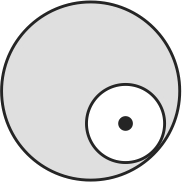359871
From a solid sphere of mass \(M\) and radius \(R\), a spherical portion of radius \(\dfrac{R}{2}\) is removed, as shown in the figure. Taking gravitational potential \(V=0\) at \(r=\infty\), the potential at the centre of the cavity thus formed is
(\(G=\) Gravitational constant)
359871
From a solid sphere of mass \(M\) and radius \(R\), a spherical portion of radius \(\dfrac{R}{2}\) is removed, as shown in the figure. Taking gravitational potential \(V=0\) at \(r=\infty\), the potential at the centre of the cavity thus formed is
(\(G=\) Gravitational constant)
359871
From a solid sphere of mass \(M\) and radius \(R\), a spherical portion of radius \(\dfrac{R}{2}\) is removed, as shown in the figure. Taking gravitational potential \(V=0\) at \(r=\infty\), the potential at the centre of the cavity thus formed is
(\(G=\) Gravitational constant)
359871
From a solid sphere of mass \(M\) and radius \(R\), a spherical portion of radius \(\dfrac{R}{2}\) is removed, as shown in the figure. Taking gravitational potential \(V=0\) at \(r=\infty\), the potential at the centre of the cavity thus formed is
(\(G=\) Gravitational constant)


